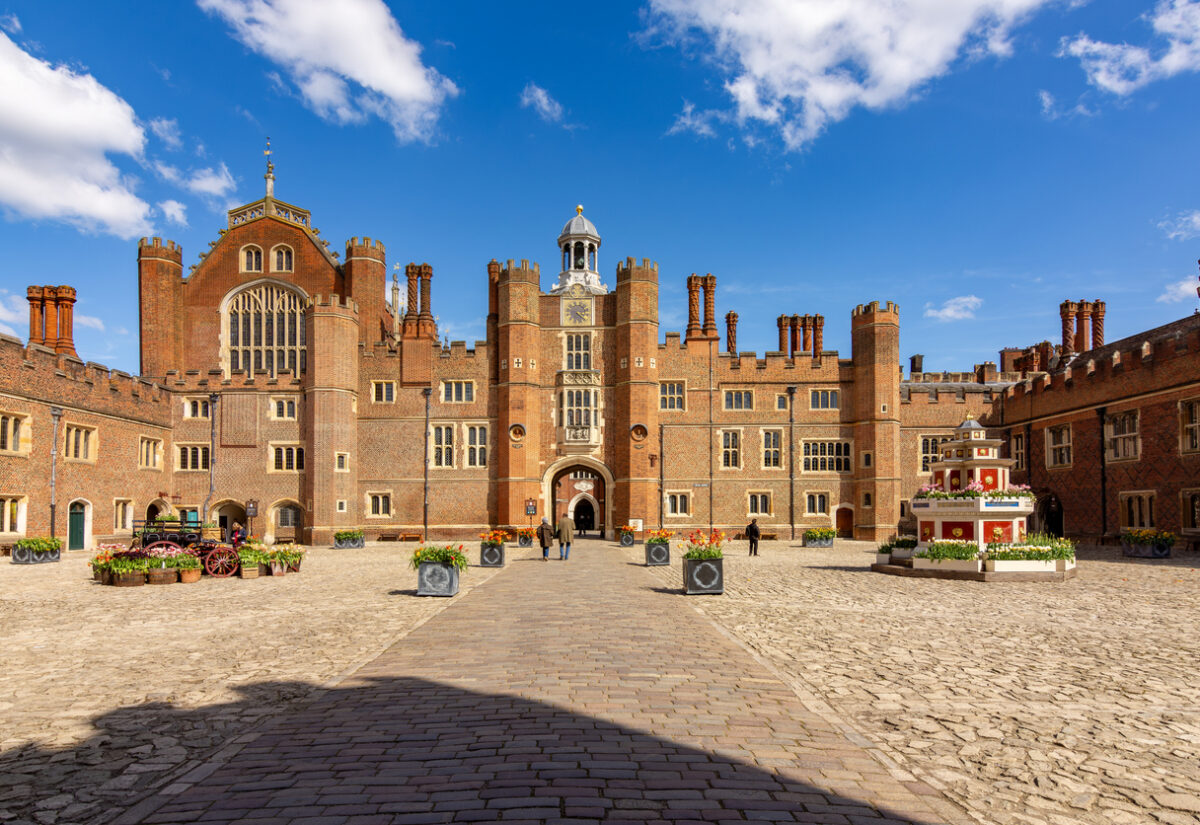 Getty Images
Getty ImagesBuckingham Palace might be the crown jewel of the British monarchy today, but it wasn’t always the centre of royal life. For centuries, kings and queens of Britain lived, ruled, and celebrated in a wide network of residences across the realm—some destroyed by fire or politics, others slowly abandoned, and a few hiding in plain sight. These forgotten royal homes were once grand, politically powerful, and architecturally dazzling, rivalling (and in some cases surpassing) the prestige of Buckingham Palace. Many of them were expressions of dynastic power, spiritual ambition, and cultural dominance. They tell a parallel story of monarchy—less known, but no less compelling.
Whitehall Palace, London
Once the largest palace in Europe, Whitehall was the principal residence of English monarchs from 1530 until it burned down in 1698. At its height, it boasted over 1,500 rooms—more than even the Vatican—and spanned 23 acres along the River Thames. It wasn’t just a royal residence but a political hub, hosting ambassadors, parliamentarians, and extravagant court masques.
Henry VIII acquired the property from Cardinal Wolsey and transformed it into a vast royal complex. Elizabeth I and James I held court here, and Charles I famously walked from Whitehall to his execution on a scaffold outside the Banqueting House—the only surviving part of the palace today, designed by Inigo Jones and still standing as a stark reminder of lost grandeur. The rest of Whitehall, with its long galleries, tennis courts, and private chambers, vanished in a devastating fire, but it had once been the beating heart of royal power.
Eltham Palace, London
Before Greenwich and Whitehall took centre stage, Eltham Palace was a favourite of the Plantagenet and early Tudor monarchs. Edward III was born there, and it served as a royal retreat well into the reign of Henry VIII, who spent much of his childhood in its ornate halls. The Great Hall, completed in the 1470s with its stunning timbered roof, remains a striking example of late medieval architecture.
Though it gradually fell out of favour as court life gravitated towards central London, Eltham had a remarkable 20th-century revival. In the 1930s, Stephen and Virginia Courtauld transformed the site into an Art Deco mansion, blending modern design with medieval stonework. The result is one of the most unique architectural fusions in Britain—part palace, part modernist fantasy, and a living showcase of Eltham’s enduring importance.
Nonsuch Palace, Surrey
Commissioned by Henry VIII in 1538 to celebrate the birth of his long-awaited son Edward VI, Nonsuch was conceived as a symbol of Tudor power and prestige. Its name said it all: there was meant to be “none such” anywhere else. It featured elaborate Renaissance-style architecture, imported Italian craftsmen, intricate stucco reliefs, and fine gardens.
Despite its magnificence, Nonsuch had a relatively short lifespan. By the late 17th century, Barbara Villiers, Countess of Castlemaine and mistress to Charles II, had it dismantled and sold off piece by piece to pay her debts. Only archaeological excavations and a few 16th-century drawings remain to hint at its lost splendour. But for a time, Nonsuch was the height of royal extravagance, and an architectural statement of Tudor ambition.
Richmond Palace, Surrey
Built by Henry VII in the 1490s on the site of the earlier Shene Palace, Richmond was a key residence of the Tudor court. With its picturesque setting along the Thames and its elegant layout of galleries, courtyards, and gardens, it became a model of early Renaissance design. Elizabeth I adored it, and she died there in 1603.
After the Civil War and the temporary abolition of the monarchy, Richmond Palace fell into neglect. Materials were stripped and sold, and today, only a few buildings, such as the gatehouse and some converted private homes, survive. Yet, its legacy lives on in the name of the surrounding area, and its riverside setting remains a reminder of a palace that once echoed with the footsteps of England’s most famous queen.
Hampton Court Palace (partially forgotten)
Still standing and open to the public, Hampton Court was one of the grandest palaces of its time. Originally built by Cardinal Wolsey before being seized by Henry VIII, it became the epicentre of Tudor opulence. Its vast kitchens, grand apartments, and maze-like corridors were designed to impress both courtiers and foreign dignitaries.
While the palace saw continued use under later monarchs, including William III and Mary II, it fell out of regular royal use by the 18th century. Today, it’s preserved as a heritage site, and while tourists walk through its rooms, it’s often overshadowed in the public imagination by Buckingham Palace. In truth, Hampton Court was once the undisputed power base of the monarchy, and its brickwork still radiates that power.
Windsor Castle (the older version)
While Windsor Castle remains in use today, much of its earlier identity has been reshaped. In its early days, it was more fortress than palace, built by William the Conqueror and expanded into a fortified royal residence under Plantagenet and Tudor kings. Its Round Tower once loomed over a more martial, defensive structure.
During the Middle Ages and well into the Tudor era, Windsor served as a symbol of authority, with royal councils held in the Great Hall and major diplomatic events hosted within its stone walls. Over time, however, it was softened into the more stately and refined version we know today. But the bones of a war-ready castle are still there, hidden under centuries of royal renovation.
Palace of Placentia, Greenwich
This palace, nestled on the Thames in what is now Maritime Greenwich, was one of the most important royal residences of the Tudor period. It was the birthplace of Henry VIII, Mary I, and Elizabeth I, and was central to early Tudor court life. With its rich brickwork and elegant towers, it became a favourite retreat and a key location for royal births, marriages, and court entertainments.
During the English Civil War, it fell into decline, and in the 17th century, it was eventually demolished to make way for the Royal Naval Hospital (now the Old Royal Naval College). Today, the baroque domes of Christopher Wren’s buildings stand where Tudor monarchs once paced, and the memory of the Palace of Placentia is known only to history lovers and scholars.
Linlithgow Palace, Scotland
Built and expanded by several Scottish monarchs over centuries, Linlithgow Palace was ideally located between Edinburgh and Stirling, making it a convenient stopover and occasional seat of court. James I, James IV, and James V all added to the structure, and Mary, Queen of Scots, was born there in 1542.
Its grand hall, arched windows, and elaborate fountain set in the courtyard made it one of the most beautiful palaces in Scotland. However, it was badly damaged during the Wars of the Three Kingdoms and never restored to its former glory. Today, its ruins are open to the public and offer a powerful, windswept reminder of Scotland’s royal past.
Falkland Palace, Scotland
Nestled in the Fife countryside, Falkland Palace was originally a hunting lodge, but under James IV and James V, it was transformed into a true palace—one of the finest examples of Renaissance architecture in Britain. With its turrets, gardens, and ornamental details, it became a beloved royal retreat.
Mary, Queen of Scots, is said to have enjoyed playing tennis here on what is now the world’s oldest real tennis court still in use. Though damaged during the Civil War, the palace was partially restored in the 19th century by the Marquess of Bute. Today, it still carries a sense of serenity and style—an understated gem of royal history.
Woodstock Palace, Oxfordshire
Woodstock was a royal residence from Saxon times through to the Tudor period. It was particularly favoured by Henry II, who famously built a retreat within the palace grounds for his mistress, Rosamund Clifford. It was later used by several monarchs as a hunting lodge, and Elizabeth I was held under house arrest there before becoming queen.
The palace was mostly destroyed during the English Civil War, and in the early 18th century, Blenheim Palace was constructed on its grounds as a reward for the Duke of Marlborough. Today, little of the original Woodstock Palace survives, but its legacy lives on in literature and legend.
These residences remind us that royal power in Britain was once far more decentralised, dynamic, and regionally spread than it is today. From riverbanks to Scottish lochs, from inner-city boroughs to rural retreats, these palaces were centres of ceremony, intrigue, and governance. Some vanished in flames or were slowly dismantled by time. Others were repurposed and reimagined for new eras. But each of them tells a piece of the larger story of monarchy—one that began long before Buckingham Palace became its centrepiece.



